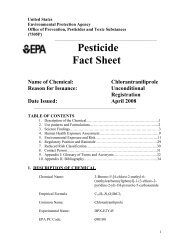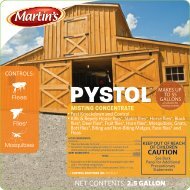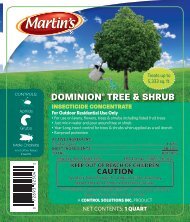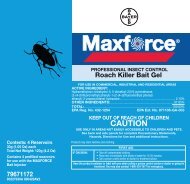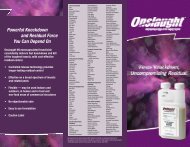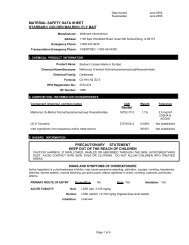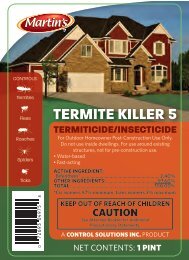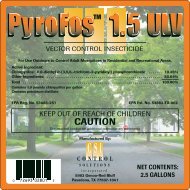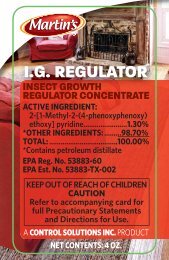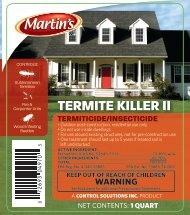Eraser
Eraser - Control Solutions, Inc.
Eraser - Control Solutions, Inc.
You also want an ePaper? Increase the reach of your titles
YUMPU automatically turns print PDFs into web optimized ePapers that Google loves.
Product Name: <strong>Eraser</strong><br />
Active Ingredient: Glyphosate<br />
EPA Reg. No. 53883-286 Page 1 of 7<br />
MATERIAL SAFETY DATA SHEET<br />
<strong>Eraser</strong><br />
Table of Contents:<br />
1. Identification of the substance/preparation 9. Physical and chemical properties<br />
and of the company/undertaking 10. Stability and reactivity<br />
2. Composition/information on ingredients 11. Toxicological information<br />
3. Hazards identification 12. Ecological information<br />
4. First aid measures 13. Disposal considerations<br />
5. Fire-fighting measures 14. Transport information<br />
6. Accidental release measures 15. Regulatory information<br />
7. Handling and storage 16. Other information<br />
8. Exposure controls/personal protection<br />
1. IDENTIFICATION OF THE SUBSTANCE/PREPARATION AND OF THE COMPANY/UNDERTAKING<br />
Product Name ................................<br />
Supplier: ........................................<br />
Emergency Telephone No. - see 16: Other<br />
Information (last page)<br />
<strong>Eraser</strong> A/P<br />
Control Solutions, Inc.<br />
5903 Genoa-Red Bluff<br />
Pasadena, TX 77507-1041<br />
2. COMPOSITION/INFORMATION ON INGREDIENTS<br />
2.1. ACTIVE INGREDIENT: Glyphosate, in the form of its isopropylamine salt<br />
Common Name ............................. Glyphosate Glyphosate, isopropylamine salt<br />
CAS Name .................................... Glycine,<br />
N-(phosphonomethyl)-<br />
Glycine, N-(phosphonomethyl),<br />
Compd. with 2-propanamine (1:1)<br />
ISO Name ...................................... Glyphosate –<br />
CAS No. ....................................... 1071-83-6 38641-94-0<br />
EC No. (EINECS No.) .................. 213-997-4 254-056-8<br />
Molecular Weight ......................... 169.07 228.18<br />
Empirical Formula ........................ C 3 H 8 NO 5 P C 6 H 17 N 2 O 5 P<br />
Structural Formula ........................ HO O<br />
HO<br />
O<br />
2.2. TYPICAL CONTENT:<br />
Active Ingredient ....................<br />
Inert Ingredients ......................<br />
Content of reportable ingredients<br />
HO<br />
P<br />
CH2 -NH-CH 2<br />
-COOH<br />
P<br />
HO<br />
CH 2<br />
-NH-CH 2<br />
-COO- + NH 3<br />
-CH(CH 3<br />
) 2<br />
Glyphosate, N-(phosphonomethyl)glycine*,<br />
as its isopropylamine salt ............................... 41.0% by weight<br />
Surfactant, water, etc. ...................................... 59.0% by weight<br />
* (Contains 480 g/l of the active ingredient glyphosate in the form of its<br />
isopropylamine salt, equivalent to about 360 g/l of the acid, glyphosate)<br />
Surfactant ........................................................ 10 - 30% by weight<br />
The information presented herein is believed to be accurate and reliable, but is presented without any warranty, express nor<br />
implied, on the part of Control Solutions, Inc.
Product Name: <strong>Eraser</strong><br />
Active Ingredient: Glyphosate<br />
EPA Reg. No. 53883-286 Page 2 of 7<br />
The surfactant has EU classification: Xn;R22 Xi;R36 N;R51/53:<br />
Harmful if swallowed. Irritating to eyes. Toxic to aquatic organisms,<br />
may cause long-term adverse effects in the aquatic environment.<br />
The product contains Tallow alkylamine ethoxylate (CAS No.<br />
61791-26-2).<br />
Material Use ................................. Herbicide<br />
2.3. EU Classification of the Product ... None<br />
2.4. WHO Classification ...................... None (Technical product unlikely to present acute hazard in normal<br />
use)<br />
2.5. US Classification ........................... Toxicity Category II, Signal Word: Warning<br />
2.6. Classification – Canada ................. Caution Irritant<br />
2.7. Health: 1<br />
Flammability: 0<br />
Reactivity: 0<br />
Personal Protection: See 8.1.<br />
3. HAZARDS IDENTIFICATION<br />
3.1. Health Hazards (Acute and Chronic):<br />
Likely Routes of Exposure ......<br />
Eye Contact .........................<br />
Skin Contact .......................<br />
Ingestion .............................<br />
Inhalation ...........................<br />
Skin contact and inhalation<br />
The product may cause pain, redness and tearing as shown by<br />
toxicity studies.<br />
The product is only slightly toxic and only slightly irritating as<br />
shown by toxicity studies.<br />
The product is only slightly toxic as shown by toxicity studies. No<br />
significant adverse health effects are expected to develop if only<br />
small amounts (less than a mouthful) are swallowed. Ingestion of<br />
similar formulations has been reported to produce gastrointestinal<br />
discomfort with irritation of the mouth, nausea, vomiting and<br />
diarrhea. Oral ingestion of large quantities of one similar product<br />
has been reported to result in hypotension and lung edema.<br />
The product is only slightly toxic if inhaled as shown by toxicity<br />
studies.<br />
3.2. Signs and Symptoms of Exposure See 3.1.<br />
3.3. Environmental Hazards ................ See 12.<br />
4. FIRST AID MEASURES<br />
4.1. Emergency and First Aid Procedures:<br />
If in Eyes ...............................<br />
If Swallowed .........................<br />
If Inhaled ...............................<br />
Immediately hold eyelids open and flush with plenty of water. Get<br />
medical attention.<br />
The product will cause gastrointestinal tract irritation. Immediately<br />
dilute by swallowing water or milk. Get medical<br />
attention.<br />
Remove individual to fresh air. If not breathing, give artificial<br />
respiration, preferably mouth-to-mouth. Get medical attention.<br />
The information presented herein is believed to be accurate and reliable, but is presented without any warranty, express nor<br />
implied, on the part of Control Solutions, Inc.
Product Name: <strong>Eraser</strong><br />
Active Ingredient: Glyphosate<br />
EPA Reg. No. 53883-286 Page 3 of 7<br />
5. FIRE-FIGHTING MEASURES<br />
5.1. Extinguishing Media and Procedure Water spray, foam, dry chemical, carbon dioxide or any class B<br />
extinguishing agent.<br />
Use water spray to keep fire-exposed containers cool. Approach<br />
fire from upwind to avoid hazardous vapors and toxic<br />
decomposition products. Fight fire from protected location or<br />
maximum possible distance. Avoid heavy hose streams. Dike area<br />
to prevent water runoff. Firemen should wear self-contained<br />
breathing apparatus and protective clothing.<br />
5.2. Hazardous Decomposition or<br />
Byproducts in a Fire .....................<br />
The essential breakdown products are carbon monoxide, carbon<br />
dioxide, phosphorus pentoxide and nitrogen oxides.<br />
5.3. Unusual Fire and Explosion Hazards None.<br />
6. ACCIDENTAL RELEASE MEASURES<br />
6.1. Personal Protection ....................... Observe all protection and safety precautions when cleaning up<br />
spills, see 8.<br />
6.2. Steps to Be Taken in Case of Spill Small liquid spills on the floor or other impervious surface, should<br />
be soaked up with towels or other absorbent material and discarded<br />
in the trash. Clean the spill area with soap and water and rinse the<br />
area thoroughly.<br />
Large liquid spills on the floor or other impervious surface should<br />
be contained or diked and then absorbed with attapulgite, bentonite<br />
or other absorbent clays. Collect the contaminated absorbent, place<br />
in a metal drum and dispose of in accordance with the instructions<br />
provided under Disposal (see 13). Thoroughly scrub floor or other<br />
impervious surface with a strong industrial detergent and rinse with<br />
water.<br />
Large spills that soak into the ground should be dug up, placed in<br />
metal drums and disposed of in accordance with instructions<br />
provided under Disposal (see 13). Contact appropriate state agency<br />
when considering a land spreading disposal option.<br />
Leaking containers should be separated from non-leakers and either<br />
the container or its contents transferred to a drum or other nonleaking<br />
container and disposed of in accordance with instructions<br />
provided under Disposal (see 13). Any recovered spill<br />
liquid should be similarly collected and disposed of.<br />
The information presented herein is believed to be accurate and reliable, but is presented without any warranty, express nor<br />
implied, on the part of Control Solutions, Inc.
Product Name: <strong>Eraser</strong><br />
Active Ingredient: Glyphosate<br />
EPA Reg. No. 53883-286 Page 4 of 7<br />
7. HANDLING AND STORAGE<br />
7.1 Precautions to Be Taken in Handling Do not get in eyes or breathe mist or get in or on clothing. Avoid<br />
breathing vapor or spray mist. Wash hands before eating, drinking,<br />
chewing gum, using tobacco, or using the toilet. Remove clothing<br />
immediately if pesticide gets inside. Then wash thoroughly and put<br />
on clean clothing (see 8, Personal Protection).<br />
Spray solutions of the product should be mixed, stored or applied<br />
using only stainless steel, aluminum, fiberglass, plastic or plasticlined<br />
containers<br />
Do not mix, store or apply this product or spray solutions of<br />
this product in galvanized or unlined steel (except stainless<br />
steel) containers or spray tanks.<br />
Do not apply directly to water, to areas where surface water is<br />
present or to intertidal areas below the mean high water mark.<br />
Do not contaminate water when disposing of equipment<br />
washwaters.<br />
7.2. Precautions to Be Taken in Storing Do not contaminate water, foodstuffs, feed or seed by storage or<br />
disposal.<br />
7.3. Fire and Explosion Precautions ....<br />
8. EXPOSURE CONTROLS/PERSONAL PROTECTION<br />
8.1. Respiratory Protection ............ The undiluted product is not likely to present an airborne exposure<br />
concern during normal handling. In the event of an accidental<br />
discharge of the material during manufacture or handling which<br />
produces a heavy vapor or mist, workers should put on respiratory<br />
protection equipment in conformity with local regulations.<br />
For application of product diluted in accordance with label<br />
instructions: Respirators are not required for applications of<br />
use-dilutions of the product.<br />
Protective gloves .....................<br />
Eye Protection ........................<br />
Skin Protection .......................<br />
Wear heavy duty, natural rubber gloves.<br />
Wear goggles, face shield or safety glasses.<br />
Wear appropriate protective clothing to prevent skin contact.<br />
Applicators and other handlers must wear long-sleeved shirt, long<br />
pants, shoes plus socks and protective eyewear.<br />
8.2. Work/Hygienic Practices .............. Do not get in eyes or get in or on clothing. Avoid breathing vapor<br />
or spray mist. Wash hands before eating, drinking, chewing gum,<br />
using tobacco, or using the toilet. Wash thoroughly with soap and<br />
The information presented herein is believed to be accurate and reliable, but is presented without any warranty, express nor<br />
implied, on the part of Control Solutions, Inc.
Product Name: <strong>Eraser</strong><br />
Active Ingredient: Glyphosate<br />
EPA Reg. No. 53883-286 Page 5 of 7<br />
9. PHYSICAL AND CHEMICAL PROPERTIES<br />
water after handling. Remove contaminated clothing immediately<br />
and wash before reuse. Discard clothing and other absorbent<br />
materials that have been drenched or heavily contaminated with<br />
this product’s concentrate. Do not reuse them.<br />
9.1. Physical State ............................... Clear, viscous solution<br />
9.2. Color ............................................. Amber-colored<br />
9.3. Odor ............................................. Practically odorless to slight amine-like odor<br />
9.4. Melting Point ................................. Below 0C<br />
9.5. Boiling Point ................................. 113C<br />
9.6. Specific Gravity ........................... 1.16 g/cm 3 at 20C<br />
9.7. Vapor Pressure .............................. For the active ingredient glyphosate (acid): 1.75 x 10 -7 mm Hg<br />
(1.31 x 10 -5 Pa) at 25C<br />
9.8. Viscosity ........................................ 43 cS at 20C, 18 cS at 40C (kinematic viscosity)<br />
9.9. Solubility in Water ........................ The product is fully miscible with water (solubility active<br />
ingredient glyphosate (acid): 10.5 g/l at 20C).<br />
9.10. Partition Coefficient n-Octanol/Water P = 4.5 x 10 -4 ; Log P = - 3.4 (active ingredient glyphosate (acid))<br />
9.11. pH ................................................. 4.5 (1% solution in water) at 20C<br />
9.12. Flash Point .................................... Above 113C<br />
9.13. Autoignition Temperature ............ N.a.<br />
9.14. Flammable Limits ......................... N.a.<br />
10. STABILITY AND REACTIVITY<br />
10.1. Chemical Stability ......................... The product is stable at ambient temperature.<br />
10.2. Hazardous Decomposition or<br />
Byproducts ................................... None (however, see 5.2.).<br />
10.3. Materials to Avoid ........................ Do not mix, store or apply this product or spray solutions of<br />
this product in galvanized or unlined steel (except stainless<br />
steel) containers or spray tanks.<br />
This product or spray solutions of this product react with such<br />
containers and tanks to produce hydrogen gas which may form a<br />
highly combustible gas mixture with air. This gas mixture could<br />
flash or explode, causing serious personal injury, if ignited by open<br />
flame, spark, welders torch, lighted cigarettes or other ignition<br />
source.<br />
Hazardous Polymerization ............<br />
Does not occur. This product can react with caustic (basic)<br />
materials to liberate heat. This is not a polymerization but rather a<br />
chemical neutralization in an acid-base reaction.<br />
11. TOXICOLOGICAL INFORMATION<br />
11.1. Health Hazards ............................. See 3.<br />
11.2. Toxicological Data:<br />
Ingestion (oral) ....................... Practically non-toxic (LD 50 , rat: > 5000 mg/kg)<br />
Skin (dermal) .......................... Practically non-toxic (LD 50 , rabbit: > 2000 mg/kg)<br />
The information presented herein is believed to be accurate and reliable, but is presented without any warranty, express nor<br />
implied, on the part of Control Solutions, Inc.
Product Name: <strong>Eraser</strong><br />
Active Ingredient: Glyphosate<br />
EPA Reg. No. 53883-286 Page 6 of 7<br />
Inhalation .................................<br />
Eye Irritation ..........................<br />
Skin Irritation .........................<br />
Allergy Sensitization ...............<br />
Carcinogenicity ......................<br />
LC 50 , rat: > 4.86 mg/l/4 h<br />
May cause substantial but temporary eye injury<br />
Practically not irritant to rabbit skin<br />
No sensitizing properties towards guinea pigs in the Magnusson-<br />
Kligmann Maximization test<br />
EPA has classified glyphosate in category E (evidence of noncarcinogenicity<br />
for humans).<br />
12. ECOLOGICAL INFORMATION<br />
The active ingredient (glyphosate (acid)) is rapidly deactivated by adsorption to clay particles.<br />
The acute toxicity of the product is:<br />
- Fish Rainbow Trout 96-hr LC 50 ................... 18.6 mg/l (static)<br />
Bluegill Sunfish 96-hr LC 50 .................. 11.9 mg/l (static)<br />
- Invertebrates Daphnia magna 48-hr EC 50 .................. 21.6 mg/l<br />
- Birds Bobwhite quail and mallard duck LD 50 > 2000 mg/kg (glyphosate (acid))<br />
- Algae Algae 72-hr EC 50 .................................. 17.4 mg/l<br />
- Bees Honey Bees , LD 50 , oral ....................... > 100 g/bee<br />
13. DISPOSAL CONSIDERATIONS<br />
Wastes resulting from the use of this product that cannot be used or chemically reprocessed should be<br />
disposed of in a landfill approved for pesticide disposal or in accordance with applicable federal, state or<br />
local procedures.<br />
Emptied container retains vapor and product residue. Observe all labeled safeguards until container is cleaned<br />
or destroyed. DO NOT CUT OR WELD ON OR NEAR THIS CONTAINER.<br />
Plastic Containers ..........................<br />
Do not reuse container. Triple rinse container. Then puncture and<br />
dispose of in a sanitary landfill, or by incineration, or, if allowed by<br />
state and local authorities, by burning. If burned, stay out of smoke.<br />
However, procedures in accordance with state and local regulations<br />
must be observed.<br />
14. TRANSPORT INFORMATION<br />
UN CLASSIFICATION:<br />
Not classified as hazardous material for transport.<br />
15. REGULATORY INFORMATION<br />
15.1. IN THE EU:<br />
Classification and Labeling<br />
(according to 88/379/EEC as amended):<br />
None<br />
15.2. Threshold Limit Value .................. OSHA PEL ACGIH TLV MAK HGV Others<br />
(USA) (USA) (Germany) (Denmark)<br />
n.a. n.a. n.a. n.a. –<br />
However, threshold limit values defined by local regulations must<br />
be observed.<br />
The information presented herein is believed to be accurate and reliable, but is presented without any warranty, express nor<br />
implied, on the part of Control Solutions, Inc.
Product Name: <strong>Eraser</strong><br />
Active Ingredient: Glyphosate<br />
EPA Reg. No. 53883-286 Page 7 of 7<br />
16. OTHER INFORMATION<br />
Emergencies in the US (spills):<br />
Emergencies in the US (medical):<br />
CHEMTREC toll free 1-800-424-9300<br />
SafetyCall International 1-(866) 897-8050<br />
Telephone Number for Information in the US<br />
(281) 892-2500 (8:00 am - 5:00 pm, Mon.-Fri.)<br />
Origin: 07-11-11<br />
The information presented herein is believed to be accurate and reliable, but is presented without any warranty, express nor<br />
implied, on the part of Control Solutions, Inc.




